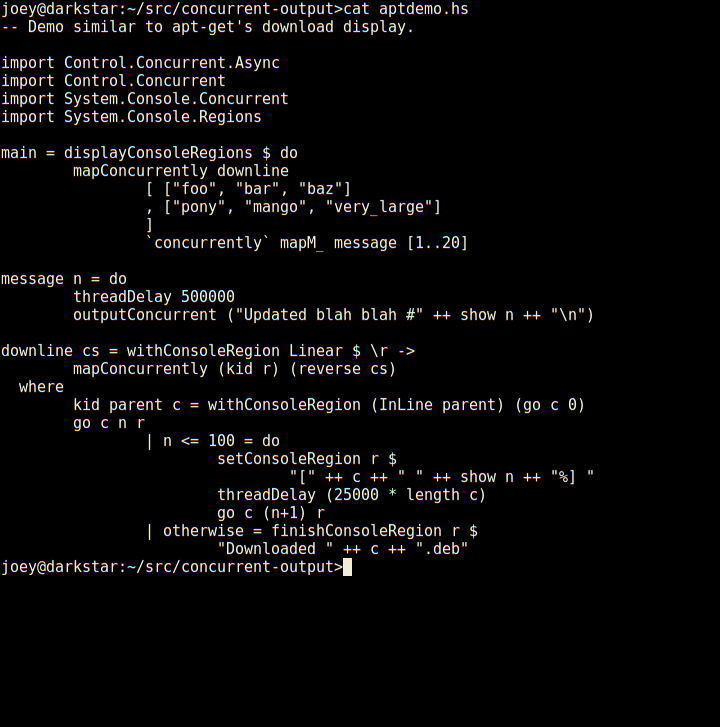Building on top of concurrent-output, and some related work Joachim Breitner did earlier, I now have a kind of equivilant to a tiling window manager, except it's managing regions of the console for different parts of a single program.
Here's a really silly demo, in an animated gif:

Not bad for 23 lines of code, is that? Seems much less tedious to do things this way than using ncurses. Even with its panels, ncurses requires you to think about layout of various things on the screen, and many low-level details. This, by contrast, is compositional, just add another region and a thread to update it, and away it goes.
So, here's an apt-like download progress display, in 30 lines of code.

Not only does it have regions which are individual lines of the screen, but those can have sub-regions within them as seen here (and so on).
And, log-type messages automatically scroll up above the regions.
External programs run by createProcessConcurrent will automatically
get their output/errors displayed there, too.
What I'm working on now is support for multiline regions, which automatically grow/shrink to fit what's placed in them. The hard part, which I'm putting the finishing touches on, is to accurately work out how large a region is before displaying it, in order to lay it out. Requires parsing ANSI codes amoung other things.
STM rules
There's so much concurrency, with complicated interrelated data being updated by different threads, that I couldn't have possibly built this without Software Transactional Memory.
Rather than a nightmare of locks behind locks behind locks, the result is so well behaved that I'm confident that anyone who needs more control over the region layout, or wants to do funky things can dive into to the STM interface and update the data structures, and nothing will ever deadlock or be inconsistent, and as soon as an update completes, it'll display on-screen.
An example of how powerful and beuatiful STM is, here's how the main display thread determines when it needs to refresh the display:
data DisplayChange
= BufferChange [(StdHandle, OutputBuffer)]
| RegionChange RegionSnapshot
| TerminalResize (Maybe Width)
| EndSignal ()
...
change <- atomically $
(RegionChange <$> regionWaiter origsnapshot)
`orElse`
(RegionChange <$> regionListWaiter origsnapshot)
`orElse`
(BufferChange <$> outputBufferWaiterSTM waitCompleteLines)
`orElse`
(TerminalResize <$> waitwidthchange)
`orElse`
(EndSignal <$> waitTSem endsignal)
case change of
RegionChange snapshot -> do
...
BufferChange buffers -> do
...
TerminalResize width -> do
...
So, it composes all these STM actions that can wait on various kinds of changes, to get one big action, that waits for all of the above, and builds up a nice sum type to represent what's changed.
Another example is that the whole support for sub-regions only involved adding 30 lines of code, all of it using STM, and it worked 100% the first time.
Available in concurrent-output 1.1.0.